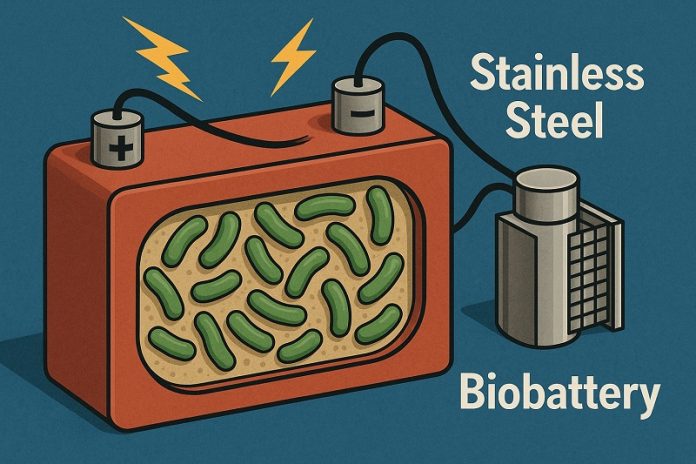
At Binghamton University, a team of researchers has developed a new kind of biobattery powered by bacteria—and a key breakthrough came from just downstairs.
Professor Seokheun “Sean” Choi has spent the past decade working on batteries that generate electricity using bacteria.
Now, thanks to a collaboration with mechanical engineering expert Dehao Liu, the team has made a major leap forward by using a new kind of stainless-steel component.
These tiny biobatteries use special bacteria in their dormant form, called endospores, which “wake up” when conditions are right. Once active, they create an electrochemical reaction that generates electricity.
For this to work, the battery needs three parts: a positive electrode, a negative electrode (where the bacteria live), and a membrane where ions move to create current.
The negative electrode—called the anode—has to be three-dimensional so the bacteria have room to grow and thrive.
A flat anode just doesn’t work as well, because nutrients can’t reach the bacteria properly and their waste can’t escape.
The problem? Traditional materials like carbon or plastic are either not strong enough or don’t conduct electricity well. Making 3D shapes out of them also involves high heat, which can kill the bacteria.
Two years ago, Choi’s team started using stainless steel mesh for the anode, which was strong and highly conductive. But the mesh wasn’t perfect—they couldn’t control its shape or texture precisely.
That’s where Liu came in. His expertise in laser powder bed fusion (LPBF), a high-tech metal 3D printing process, allowed the team to custom-print stainless-steel components for the battery. This technique gives total control over the design, down to the tiniest details.
Using this method, they built the anode, a sealing cover, and other parts—essentially snapping them together like Lego pieces.
The result? A stack of six biobatteries produced nearly 1 milliwatt of electricity—enough to power a small LCD screen. It’s one of the most powerful versions of Choi’s biobattery yet. Even better, the bacteria can be removed and reused without losing performance.
Former student and now collaborator Anwar Elhadad said the work builds on his own PhD research and praised Choi’s openness and vision. The team now hopes to develop a unified way to print the entire battery in one go and to improve energy storage with a management system, similar to how solar panels store power.
This work points to a future where bacteria might help power the tiny electronic devices that connect our world—from environmental sensors to medical tools—using nothing more than nature and smart engineering.



